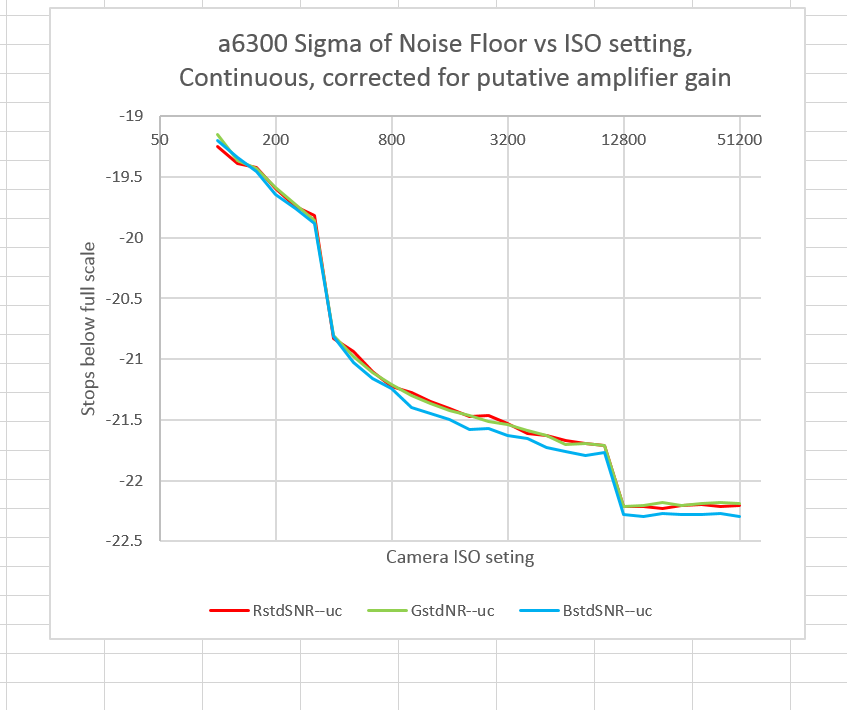Thie is the first in a series of posts about the Sony alpha 6300, aka a6300. The best way to navigate to all the other posts in the series is to scroll down to the bottom of this post — below the comments — and there you’ll find pingbacks to the other posts in the series. Just click on the ones that interest you.
The Sony alpha 6300 arrived today, and I wasted no time getting started on testing. The first think I did was look at read noise versus ISO. This is an easy test to do because Sony doesn’t do any in-camera black point subtraction, so what you see is what you got.
I made a series of captures with the camera set up in raw mode (there’s no choice of compressed or uncompressed), body cap affixed, shutter set to 1/1000 second, at each of the possible ISO settings, with the shutter in single shot mode/EFCS on, continuous/EFCS on, and silent (fully electronic).
I analyzed a 200×200 pixel central spot wit RawDigger, measuring the standard deviation of the dark-field noise for three raw channels.
Here’s what the noise floor looks like versus ISO setting.
The vertical axis is logarithmic, and reads the noise in stops below full scale. There is no significant variation among the raw channels. But there is something very interesting, that jump downward as the ISO knob is turned from 320 to 400. We’ve seen something like that before on both the a7S and the a7RII. On the a7S the transition occurs as you go from ISO 1600 to ISO 2000. On the a7RII the change occurs as you go from ISO 500 to ISO 640.
To me, this is clear evidence that Sony is using the Aptina dual-conversion gain technology in the a6300, switching out a capacitor at each pixel to raise the conversion gain, probably by a factor of 4.
Bill Claff would say that this camera has two base ISOs, 100 and 400.
Does the same thing happen in other shutter modes?
The read noise is higher in continuous mode. In other recent Sony cameras, that is because the ADCs drop down to 12 bits in that mode and they get noisier to boot. That’s probably what’s happening here. I’ll be looking explicitly at this issue in a future post.
Silent shutter mode has essentially the same noise as continuous shutter mode. That’s an improvement over the way the a7S works.
Many of you are not used to seeing noise curves like the above, but are accustomed to viewing Engineering Dynamic Range curves, For you, here is the same information in a more familiar form
We can massage the read noise date to get it referred to the input of the amplifier in the standard sensor model. Note that that model doesn’t apply to the a6300, since it changes conversion gain, but it’s useful to see where the camera is “ISOLess”.
In all single shot shutter mode, the camera is essentially ISOless from 100 to 320, and 400 to 5000. In continuous and silent shutter modes, there is a noise advantage in tracking light levels and making ISO corrections.
Those ripples in the curves at nosebleed ISOs are probably the result of Sony doing some digital signal processing. I’ll be looking at that.
More to come.









Looks like you are having fun with the newly arrived a6300. Thanks.
The EDR looks impressive for a APS-C crop camera. Is it comparable apples vs apples to the EDR for the full-frame a7Rii? Any idea how it compares to the earlier a6000?
Is EDR about what DxoMark reports for DR? I think Bill Claff reports PDR, which ends up having lower values.
And hope your recovery continues to go well.